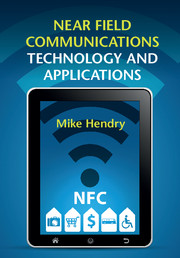Book contents
- Frontmatter
- Contents
- Part I Introduction
- Part II Technology
- 3 Standards
- 4 Modes of operation
- 5 RF requirements and components
- 6 The Secure Element
- 7 Tags and terminals
- 8 NFC apps
- 9 Infrastructure requirements
- 10 Security
- 11 Interoperability
- Part III Applications
- Part IV Implementation
- Appendix A Glossary
- Appendix B Standards
- Index
- References
8 - NFC apps
from Part II - Technology
Published online by Cambridge University Press: 05 December 2014
- Frontmatter
- Contents
- Part I Introduction
- Part II Technology
- 3 Standards
- 4 Modes of operation
- 5 RF requirements and components
- 6 The Secure Element
- 7 Tags and terminals
- 8 NFC apps
- 9 Infrastructure requirements
- 10 Security
- 11 Interoperability
- Part III Applications
- Part IV Implementation
- Appendix A Glossary
- Appendix B Standards
- Index
- References
Summary
Basic, feature and smart
Mobile phones are usually divided into three groups: basic, feature phones and smartphones.
Basic phones are mainly designed for voice calls and text messaging. They may offer a few extra features such as an alarm clock or calculator. All GSM phones also offer the SIM toolkit (STK) and USSD (Unstructured Supplementary Service Data) functions; these allow a wide range of services, but in general the services have to be tailored to the specific model of phone and delivered by a central server. The majority of networks in the USA, and in several other countries, use CDMA (Code Division Multiple Access) rather than GSM; these services are less standardized and more dependent on the network, so basic phones can have more or fewer features than basic GSM phones. Because they are designed to be low-cost and there is no option to download new apps into the phone under user control, this class of phone is unlikely to have any NFC capability.
The first NFC phones were feature phones supporting the Java™ Micro Edition (Java ME) language, allowing applications to be downloaded by a service provider, usually by agreement with the MNO as the application is likely to be stored in the SIM card. Most GSM feature phones also have WAP support or GPRS capability, which support higher data-rates and browser-like functions. This makes them suitable for some NFC services, but many of the more popular services are likely to require a full-function browser and larger screen size. Feature phones represent a price-sensitive sector so manufacturers are less likely to incorporate NFC antennae or chipsets as standard, nor to invest heavily in what are now older designs.
- Type
- Chapter
- Information
- Near Field Communications Technology and Applications , pp. 81 - 92Publisher: Cambridge University PressPrint publication year: 2014



